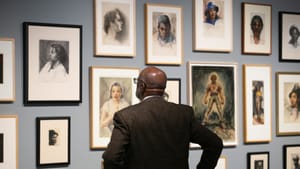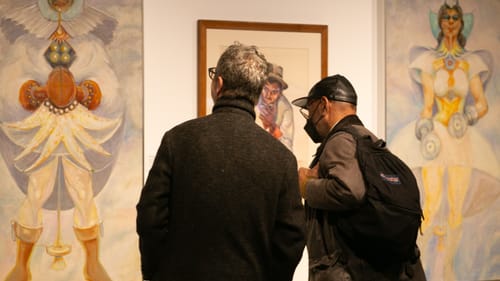Stay in the Loop
BSR publishes on a weekly schedule, with an email newsletter every Wednesday and Thursday morning. There’s no paywall, and subscribing is always free.
Remembering a revelatory Philadelphia artist
AAMP Presents IMPRINT: Dox Thrash Black Life, and American Culture

Dox Thrash should need no introduction, and yet. There appears to be an ongoing need to remind us of how revelatory his art was. Now on view at the African American Museum in Philadelphia, IMPRINT: Dox Thrash Black Life, and American Culture considers his significance.
Thrash (1893-1965), a painter, watercolorist, and printmaker, made the everyday lives of ordinary Black people visible. He is known for inventing and perfecting the carborundum print technique, which in his hands, produced tones and textures so varied and substantial that the eye can almost feel what it sees—fluffy cotton, splintered wood, muscles straining against a burden, and hands roughened on scrub boards. Thrash conveyed the difficulty, delight, and dignity of Black people in the rural South and urban North at a time when many people scarcely noticed their existence.
Student, worker, veteran, artist
Thrash was born in Griffin, Georgia, and left school after fourth grade. He studied art through correspondence courses, moved north in the Great Migration, worked as an elevator operator, and took night courses at the School of the Art Institute of Chicago.
He served in World War I as a Buffalo Soldier, a segregated unit. Military service would enable Thrash to study at the Art Institute full time, and his practice flourished in the Black cultural renaissance of the 1920s and 1930s, which produced music, literature, theater, and visual art preserving and celebrating the African American experience.
During the Great Depression, artists were among those benefitting from a cascade of federal relief programs aimed at restoring gainful employment and a sense of civic pride. One agency in the Roosevelt Administration’s New Deal, the Works Progress Administration, included the Federal Art Project, which hired thousands of artists to create works for public spaces. Gallery notes explain that the Harlem Artists Guild advocated with the WPA for the inclusion of Black artists. Thrash was among them.
Printing innovation
By then, living in Philadelphia, Thrash was named in 1937 to supervise the Federal Art Project’s only print-focused center, the Fine Print Workshop of Philadelphia. It was in this capacity, working with fellow artists Michael Gallagher and Hubert Mesibov, that Thrash invented the carborundum mezzotint. He christened it the “Opheliagraph” after his mother.
Rather than incising images on smooth plates, the method called for abrading printing plates with carborundum, a hard material used in disc brakes and bulletproof vests. The resulting gouges enabled plates to hold more ink. Images were then built by smoothing selected sections. As Thrash described, “I… rubbed [carborundum powder] into a copper plate with an old flatiron. I got a queer rough surface … little bits of metal stick up like hills … all you have to do is take a burnisher and smooth out the parts you want to register light on the paper … You can make your hills and valleys of different depths, and get all sorts of shades, blending into one another.”
The technique is used to perfection in Georgia Cotton Crop (c. 1944-45), depicting a tumbledown shack surrounded by snowy mounds of cotton. Nearby, a tiny birdhouse balances atop a tall pole, looking sturdier than the human dwelling.

The tilting shack, with its uneven porch and lacy roof, is an important symbol of home for Thrash and other Black printmakers, according to art historian Leslie King Hammond. Speaking about Black printmakers and the WPA at Woodmere Art Museum in 2015, she noted, “These houses were often hand-built … Simple structures which were challenged by the environment and challenged by the lack of materials.” They were “special houses that supported the lives, the goals, the cultures … the spiritual release of these people.”
A Philadelphia practice
Thrash lived and practiced in Philadelphia from the mid-1920s to the end of his life, and was active in Black cultural and social clubs. IMPRINT includes numerous images of the city, cast from Thrash’s humble, ground-level perspective. Drawing for News Corner, aka 9th & Ridge (c. 1937) takes us into a pocket only locals would know, where advertisements plaster a backyard fence and neighbors huddle over newspapers.
Workers populate Thrash’s images. Dockworkers unload cargo, carpenters shoulder planks, and fishermen haul nets (like Heave!, c. 1939-1940). In Help Wanted (c. 1930), a pair of women dressed in their Sunday best wait in an employment office. Farm women churn butter, tend sparse flocks of chickens (Blue Monday, c. 1940-41), and head into a dairy shed in the rare color carborundum etching, Milking (early 1940s).
Doing the wash, and doing it on Monday, is a running theme, but only one laundress is identified: Nellie Scott (c. 1940), who leans over a steaming washtub. Nellie’s face is shaded by a jaunty little hat, but we see her wet forearms glistening.
Thrash’s watercolor World War I Soldier (c. 1920) could be a self-portrait, and in Coming Home (c. 1945), he shows a sailor, ditty bag slung over a shoulder, about to turn into his narrow street, where a joyous banner waits.
Recognition and respect
From his perch in the Sharswood neighborhood north of Center City, then a thriving Black community of restaurants, hotels, and jazz clubs, Thrash knew that what you see depends on where you stand. He frames the distant skyline of Old Philadelphia (c. 1940) in listing poles, drooping wires, weedy sidewalks, and buildings in need of some love. (Thrash's home, which still stands and is the focus of preservation efforts, was added in 2013 to Philadelphia’s Register of Historic Places.)
Thrash’s subjects live everyday lives. The little girl of Life (c. 1938-39) reads a big book in a grownup chair. The prim churchgoer of Sunday Morning (c. 1939) walks along, head high, clutching her prayer book. The woman of Saturday Night (c. 1942-45) irons her hair before a date. The people he depicted are individuals, recognizable, and respectfully presented. In Thrash’s lifetime, this was noteworthy. For some encountering the images today, it may still be. Hence the need to revisit them and the artist who made them.
What, When, Where
IMPRINT: Dox Thrash Black Life, and American Culture. $10-$14. Through August 4, 2024, at the African American Museum in Philadelphia, 701 Arch Street, Philadelphia. (215) 574-0580 or aampmuseum.org.
Accessibility
AAMP provides barrier-free access for physically disabled guests. For more information, call (215) 574-0380 during museum hours (Thursday-Sunday, 10am-5pm).
Sign up for our newsletter
All of the week's new articles, all in one place. Sign up for the free weekly BSR newsletters, and don't miss a conversation.
